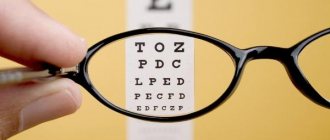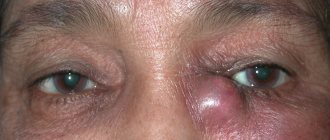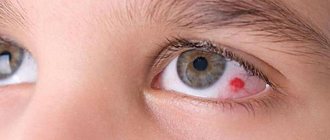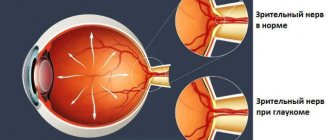Visual stress is the cause of myopia
Myopia is a refractive error in which a person sees well up close but poorly at distance. This condition can develop for various reasons. Among them:
In this article
- Visual stress is the cause of myopia
- Why is radiation from screens and monitors dangerous?
- Visual stress mode when working at a computer
- Visual loads with high myopia
- Control of visual mode in myopia
- Gymnastics for the eyes for myopia
- hereditary factor;
- lack of vitamins and minerals;
- displacement of the lens due to injury;
- spasm of accommodation;
- keratoconus.
There is another reason for myopia. These are increased loads on the visual apparatus. Myopia, which develops because of this, is called accommodative-hydrodynamic. An increase in visual load often occurs at school age. During this period of time, the eyeball grows very actively. Working at a computer for a long time and reading books often causes:
- overwork of the eye muscles;
- increased eye pressure;
- changes in the sclera.
Unfortunately, it is very difficult to reduce the load on the visual organs. Many people's work involves computers. It is difficult for office workers and schoolchildren to do without them. In order not to harm your eyesight, it is important to follow the recommendations for working at the computer and when handling other gadgets.
Asthenopia is the rapid onset of eye fatigue during visual work, especially if the eyes are at a short distance from the object. Asthenopia itself is not a disease. This is just a borderline state. But when left unattended, it can lead to the development of a more serious disease. That is why it is important to deal with this problem in a timely manner and eliminate it.
Causes of asthenopia
- — Work at a computer, regardless of the quality of the monitor.
- — Driving a car for a long time, especially at night and in the twilight.
- - Work that requires constant visual attention.
- - Reading for a long time.
- — Watching TV shows every day.
- — Glasses or contact lenses that are not fitted correctly.
- — Incorrect selection of lighting in the workplace or living space.
Types of asthenopia
Accommodative asthenopia is the most common form of visual fatigue. It can develop due to farsightedness, spasm of accommodation, weakened accommodation due to general diseases. With farsightedness, accommodation is stronger, especially when examining objects at close range for a long time, therefore accommodative asthenopia can be found more often among farsighted people.
Muscular asthenopia is eye fatigue caused by convergence overstrain. To eliminate unpleasant phenomena, it is necessary to close one eye, thus turning off convergence. Muscular asthenopia can cause the development of divergent strabismus.
Mixed asthenopia is a combination of muscular and accommodative visual fatigue. Its causes are a combination of the causes of each of them. When treating, you can use a combination of drugs. Neurogenic asthenopia is usually a manifestation of general hysteria and neurasthenia. Therefore, it can develop when there are no prerequisites for the development of asthenopia on the part of the visual organ.
Symptomatic asthenopia is a symptom that accompanies some inflammatory diseases of the nose and eyes. Its connection to long-term eye strain due to close work is less clear.
Manifestation of the disease
Symptoms of asthenopia are divided into “visual” and “ocular”. In such cases, the following may occur:
- - blurry and double images,
- - lacrimation,
- - a veil before the eyes,
- - inflammation of the eyes,
- - distortion of the size and shape of the objects in question,
- - increased eye temperature, feeling tired,
- - a feeling of discomfort in the eyes, stinging, pain or burning.
In addition, the person is bothered by frequent headaches and irritability. Against this background, complications may develop in the form of blepharitis (inflammation of the eyelids) or conjunctivitis.
Treatment of asthenopia
For presbyopia, hypermetropia and astigmatism, early prescription of glasses for vision correction is possible. Children wear glasses all the time, adults (if diagnosed with hyperopia or mild or moderate presbyopia) - as a rule, only when reading or writing.
Disease prevention
When working hard, let your eyes rest for 10-15 minutes every hour. The best way to do this is to look outside the window, admiring the landscape, looking from distant objects to nearby ones, or looking at the sky. Set the correct position and illumination of the monitor, and in general the illumination of the workplace and room.
Try to avoid sudden changes in light - you cannot work in a dark room behind a brightly lit monitor. Choose a comfortable position for work. In order for vision to be good and asthenopia not to develop, it is important that there is good blood supply. Therefore, when you look away from the monitor, do physical exercises or massage the collar area.
Use ED Medicine colloidal phytoformulas containing all the ingredients you need to strengthen your eyes, protect your retinas, and support optimal vision.
Why is radiation from screens and monitors dangerous?
The danger is not the fact of working at a computer, but electromagnetic radiation. It often causes headaches, fatigue, which turns into asthenopia, and becomes a cause of nervousness. Radiation from a computer monitor operates over a fairly large radius - about 1.5 m from the screen. Laptops also pose an eye hazard. They are located closer to the visual organs than desktop computer monitors, and therefore have a greater impact on vision.
Users of smartphones and e-readers should be aware that these gadgets also affect vision. The greater impact comes from TFT liquid crystal displays. Their main difference is that they emit light on their own. When using smartphones, your eyes need to constantly concentrate on the screen. Because of this, a person blinks less often, which can cause “dry eye” syndrome, a condition in which the cornea dries out. While reading e-books or using a smartphone, the visual organs are in a sedentary state. Very often this causes a spasm of accommodation. This condition leads to the development of myopia.
Causes of eye fatigue
Asthenopia is a rapidly occurring fatigue of the organ of vision during operation, especially when viewing objects at close range. This feeling is not a pathology, but if it is neglected, it can lead to serious visual impairments.
The most common causes of asthenopia:
- Long-term overstrain of the organ of vision.
- Watching TV, working with a computer, gadgets.
- Continued reading of books in electronic or paper form.
- Incorrectly selected lenses or glasses.
- Inadequate lighting of the workplace.
- Stay outside or indoors with dry air.
The above factors reflect only errors in visual hygiene, the violation of which contributes to the formation of a feeling of eye fatigue. A fundamentally important role in the development of this condition is played by existing pathologies of the visual apparatus and the human body as a whole.
Based on this, there are 5 types of asthenopia:
- Accommodative.
- Muscular.
- Asthenic.
- Symptomatic.
- Nervous.
Accommodative asthenopia
The causes of this form of visual fatigue are:
- Uncorrected farsightedness.
- Age-related decrease in near vision (usually over 40 years of age).
- Astigmatism.
Due to the above diseases, tension occurs in the ciliary (ciliary) muscle of the eye, which regulates the shape of the lens. As a result, it is noted:
- Muscle fatigue.
- Reducing the force of its contraction.
- Weakening of the eye's ability to normally view objects at different distances.
In childhood, symptoms of asthenopia sometimes occur, but as the child develops, they can disappear due to an increase in the size of the eyeball and improved performance of the ciliary muscle.
Muscular form of eye fatigue
Under normal conditions, when viewing nearby objects, 2 important processes occur in the organ of vision:
- Contraction of the ciliary muscle. This leads to a change in the shape of the lens, as a result of which light falls clearly on the retina, thereby creating a high-quality image.
- Contraction of the extraocular muscles. Their tension leads to the reduction (convergence) of the eyes to the object being viewed close and the formation of a three-dimensional image on each of the organs (binocular vision).
With this type of asthenopia, tension occurs in the extraocular muscles, while the ciliary muscles can remain in a relaxed state. Due to such a discrepancy in their work, the eye is forced to work in an “exhausting” mode, which provokes the appearance of symptoms of its fatigue.
Muscular asthenopia accompanies people with myopia.
Asthenic form
It occurs as a result of general pathologies of the body, infectious processes, mental and physical overstrain, and incorrect rest and work schedule.
Symptomatic type of asthenopia
This form is spoken of when asthenopia is one of the symptoms of an inflammatory or other pathological process in the organ of vision. Often, visual fatigue is the first sign of a serious ophthalmological disease.
Symptoms of asthenopia can occur due to inflammation in the ears or paranasal sinuses. This is due to the close location of anatomical structures.
Nervous eye fatigue
It is a diagnosis of exclusion when, as a result of examinations, all the above-mentioned causes of this condition were eliminated.
This form of eye fatigue can occur due to neuroses, stress, neurasthenia, and hysteria. Treatment in this case is carried out by a psychiatrist or neurologist.
Visual stress mode when working at a computer
It is very difficult for adults and children to cope without a computer and other gadgets today. But you can follow the regime recommended for visual work. An adult can spend no more than 6 hours a day at a computer. After every half hour, it is recommended to perform visual gymnastics. This is a good prevention of vision problems. You can work at the monitor for no more than 2 hours at a time. After this, you need to take a break for at least 20 minutes. At this time, it is advisable to take a walk, or, if possible, go outside. For children, the visual load regime is more stringent. The time a child can spend at the computer depends on age. Ophthalmologists do not recommend giving smartphones or tablets to children under 5 years of age. Primary school students can use a computer no more than 30 minutes a day. While working, it is important to take breaks every 10 minutes and perform a few simple eye exercises. Secondary school students are allowed to spend about an hour on the computer. Work breaks are required. They should be done every 20 minutes.
The duration of visual load should depend on how the workplace is equipped. It is advisable that the computer monitor be located 15-20 cm below eye level. The distance from the visual organs to the screen should be at least 50-70 cm. For myopia, it is important that the height of the chair and table be adjusted. The workplace should be well lit and, if possible, located near a window. For right-handed people, the light should come from the left side. For left-handed people it's the other way around. Light should not shine into the eyes.
Visual loads with high myopia
Particular attention to the duration of visual work should be paid to people with a high degree of myopia. For myopia greater than 6D, it is important to reduce visual load as much as possible. The work schedule must include breaks. Ophthalmologists recommend spending no more than 30 minutes at a time at the computer or reading books. After half an hour of work, you need to give your eyes time to rest. It is best to perform several visual gymnastics exercises. You can close your eyes for 10 minutes and blink. This will help relax the eye muscles. After this you can return to work. If working conditions do not allow you to rest every half hour, then you should adhere to the “20-20-20” rule. Every 20 minutes you need to take a short break, the duration of which is 20 seconds. At this time, you should blink your eyes 20 times. This simple exercise is a good prevention of progressive myopia. It improves blood flow and facilitates the work of the ciliary muscle of the eye. Scientists have proven that accommodation spasm does not go away during sleep, so visual stress should be eliminated before bedtime.
One of the signs of high myopia is frequent headaches. They arise due to non-compliance with the load on the visual organs. You should not read books lying on your side. In a lying position, the level of lighting is disrupted. This can stretch the posterior pole of the eye and the optic nerve head. Performing visual work while lying on your side quickly leads to fatigue and often causes asthenopia. This condition does not belong to the category of diseases, but is still quite dangerous.
Prevention. Advice from ophthalmologists. Eye exercises
Prevention of visual fatigue includes:
- undergoing regular medical examinations with an ophthalmologist, thanks to which it is possible to promptly diagnose and treat eye diseases;
- carrying out adequate correction of visual impairments;
- performing work that requires visual strain in good lighting;
- maintaining a distance from the monitor (no closer than 50 centimeters) when working with a computer;
- alternating eye strain with rest (take 10-15 minute breaks every hour of work);
- ensuring a comfortable body position in which blood circulates freely throughout the body, supplying all organs with nutrients and oxygen;
- balanced and nutritious nutrition;
- taking vitamin complexes for the eyes;
- massage of the collar area;
- playing sports;
- daily walks in the fresh air.
A central place in the prevention of asthenopia and dangerous consequences is occupied by special eye exercises that have a complex effect. They relax and strengthen the eye muscles, activate the circulation of blood and intraocular fluid, thereby effectively reducing visual fatigue.
Control of visual mode in myopia
To independently control the load on the organs of vision, you can use the tables of Sivtsev or Golovin. They are easy to find on the Internet and print. If a person uses glasses during visual work, then the vision test should be carried out wearing them. It is best to position the table so that it is clearly visible from the workplace. For example, if the computer is located opposite the wall, then the table can be placed on it. This method will help you pay attention to how quickly eye fatigue occurs during visual work.
Load control should be carried out before starting work. After this, it must be repeated after 1-2 hours. Regularity depends on the degree of myopia. If during the test it was noticed that vision has become worse - it is more difficult for a person to see the symbols in the table that he successfully examined several hours ago, then it is necessary to perform eye exercises. Simple exercises will help restore your vision. For mild myopia, looking at Sivtsev’s or Golovin’s tables allows the eyes to rest. If the organs of vision focus on a distant object, this reduces visual fatigue and prevents overstrain of accommodation.
Gymnastics for the eyes for myopia
Under high loads and visual disturbances, it is very important to perform eye exercises. Exercise helps train the eye muscles. This prevents the development of accommodation spasm, which often leads to myopia. It is recommended to repeat the exercises every day. It is best if their implementation is comprehensive. You can devote time to exercising your eyes during breaks at work, while doing household chores, etc. To give your eyes a rest, you can blink for 1-2 minutes. This will help your visual organs relax a little. Eyelid massage helps relieve fatigue. One of the effective exercises is the figure eight.
To perform it, you need to close your eyes and try to “draw” the number eight with your gaze. You can't move your head while doing this. The exercise should be performed slowly, without sudden movements. To achieve greater effect, ophthalmologists recommend repeating the exercise at least 5 times.










